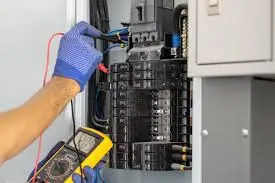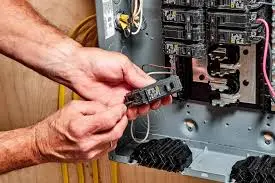Circuit breakers play a crucial role in electrical systems by protecting circuits from overloads and short circuits. Understanding the types and functions of circuit breakers is essential for maintaining a safe and efficient electrical system in your home or business.
Table of Contents
ToggleCircuit Breaker Basics

What Is a Circuit Breaker?
A circuit breaker is a safety device that automatically interrupts electrical flow in a circuit when it detects an overload or a short circuit. This prevents damage to appliances and wiring and reduces the risk of electrical fires.
Types of Circuit Breakers
- Standard Circuit Breakers: These are the most common type of circuit breakers and are used in residential and commercial buildings to protect branch circuits.
- Ground Fault Circuit Interrupters (GFCIs): GFCIs are designed to protect against electric shock and are typically installed in areas where water is present, such as kitchens, bathrooms, and outdoor outlets.
- Arc Fault Circuit Interrupters (AFCIs): AFCIs detect dangerous arcing in electrical circuits and can help prevent electrical fires.
- Miniature Circuit Breakers (MCBs): MCBs are compact circuit breakers used in low-voltage electrical systems.
- Residual Current Circuit Breakers (RCCBs): RCCBs are used to protect against electric shock by detecting small imbalances in the electrical current.
Functions of Circuit Breakers
Overload Protection
Circuit breakers protect against overload by automatically shutting off power when the current exceeds a certain limit. This prevents overheating and damage to wiring and appliances.
Short Circuit Protection
Short circuits occur when a hot wire comes into contact with a neutral or ground wire, causing a sudden surge in current. Circuit breakers detect short circuits and quickly interrupt the flow of electricity to prevent damage.
Ground Fault Protection
Ground faults occur when an electrical current finds an unintended path to the ground, which can result in electric shock. GFCIs and RCCBs are designed to detect ground faults and quickly shut off power to prevent injury.
How to Check Circuit Breakers

Visual Inspection
Inspect circuit breakers for signs of damage, such as burning or melting. Also, check for tripped breakers, which are indicated by a switch that is in the “off” position.
Use a Multimeter
A multimeter can be used to test the continuity of a circuit breaker. Set the multimeter to the continuity setting and touch the probes to the terminals of the circuit breaker. If the circuit is closed, the multimeter will beep.
Multi-Wire Branch Circuits
A multi-wire branch circuit is a wiring scheme that allows multiple circuits to share a common neutral wire. This can help reduce the number of wires needed and is commonly used in residential wiring.
Benefits of Multi-Wire Branch Circuits
- Cost Savings: Reduced material and labor costs.
- Space Savings: Requires less space in electrical panels.
- Efficiency: Can improve the efficiency of electrical systems.
How to Install a New Circuit Breaker

Turn Off Power
Before installing a new circuit breaker, turn off the main power to the panel to prevent electric shock.
Remove the Panel Cover
Remove the cover from the electrical panel to access the circuit breaker.
Install the Circuit Breaker
Insert the new circuit breaker into an empty slot in the panel and snap it into place.
Connect the Wires
Connect the hot wire to the breaker and the neutral wire to the neutral bar in the panel. Also, connect the ground wire to the ground bar.
Test the Circuit Breaker
After installation, test the new circuit breaker to ensure it is functioning properly.
Conclusion
Circuit breakers are essential components of electrical systems, providing protection against overloads, short circuits, and ground faults. Understanding the types and functions of circuit breakers can help you maintain a safe and efficient electrical system in your home or business. By following proper installation and maintenance procedures, you can ensure that your circuit breakers continue to protect your electrical system for years to come.
